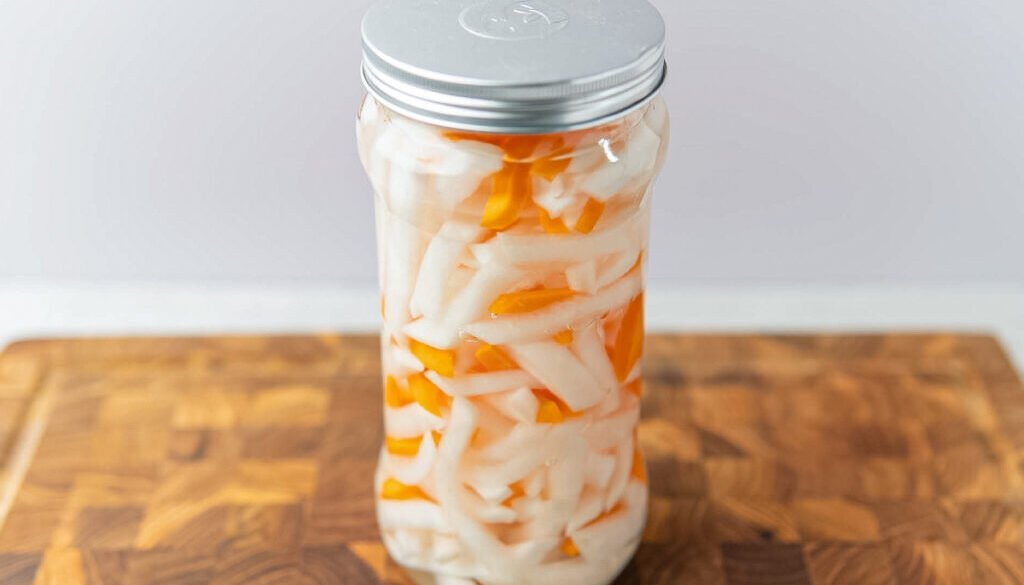Đồ chua – Vietnamese Pickled Carrots and Daikon
With a crunchy texture and slightly sour taste, Đồ chua – Vietnamese pickled carrots and daikon is a side dish that goes well with salty or fatty food in Vietnamese cuisine. It is an essential part of the Banh mi, Com tam, Bot chien, and Bun thit nuong.
If you have ever tried Vietnamese food, you have enjoyed many dishes served with pickles, a side dish with a special flavor that helps the dishes somewhat reduce the fatty taste. In this post, learn how to make your own Đồ chua – Vietnamese pickled Carrots and Daikon most simply.
Daikon radish is a very popular ingredient for Vietnamese people, because in the old times, Vietnamese people’s lives were impoverished, so simple side dishes with rice and bread were often used by Vietnamese people.
The method of making vegetables sour is by soaking them in salt. The most common salted dishes are pickles and pickled eggplants.
When I was in Vietnam, I didn’t have to make pickled stuff very often, but since I migrated to the US and had to cook my own food, I realized that the slightly sour flavors of radishes and carrots made the dishes more delicious and less greasy.
This pickled radish recipe is even more special because it is the recipe my mother used to create and taught me how to make it.
What is đồ chua?
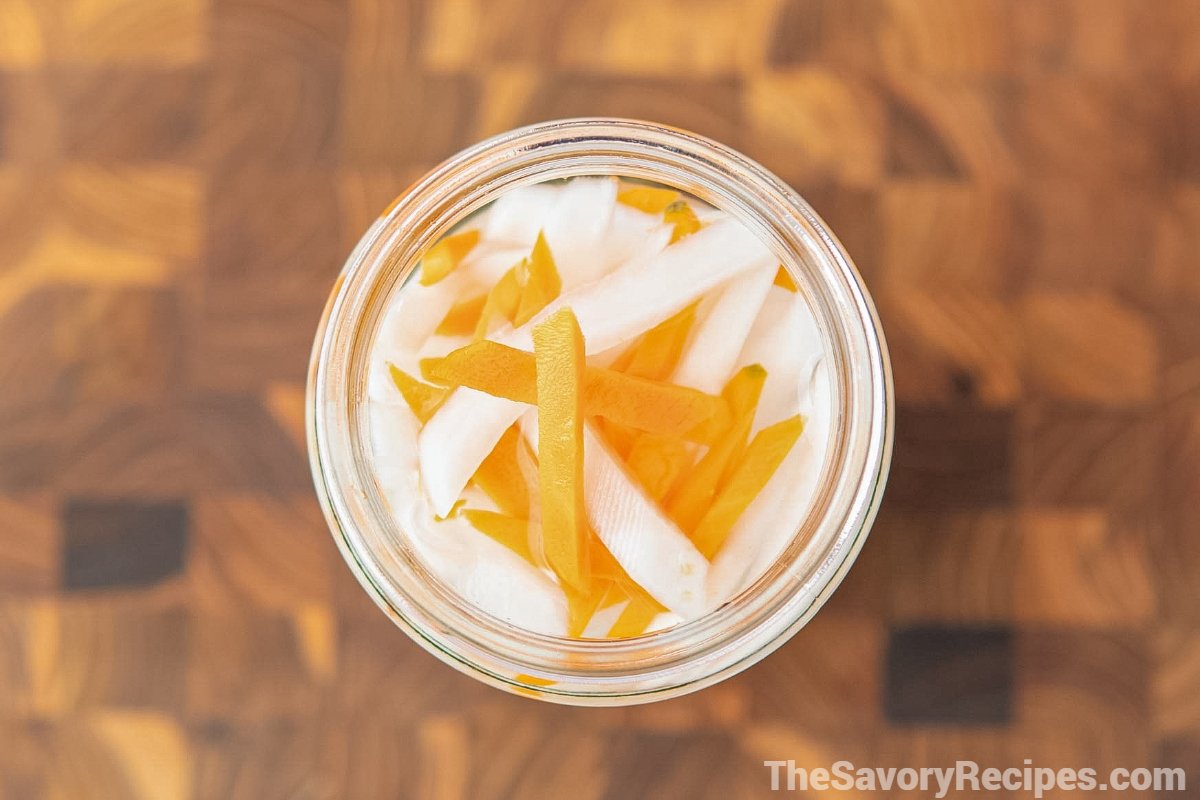
Vietnamese Pickled Carrots and Daikon (Đồ Chua) is an essential, meaning “sour stuff” in Vietnamese, which is a common condiment used in many Vietnamese dishes such as Bánh mì (Vietnamese sandwiches), Cơm tấm (Vietnamese broken rice), Bột chiên (Fried rice flour cake), Bún thịt nướng ( Vietnamese grilled pork and noodles), Bánh xèo (Vietnamese savory crepes)
How to make Vietnamese pickled carrots and daikon?
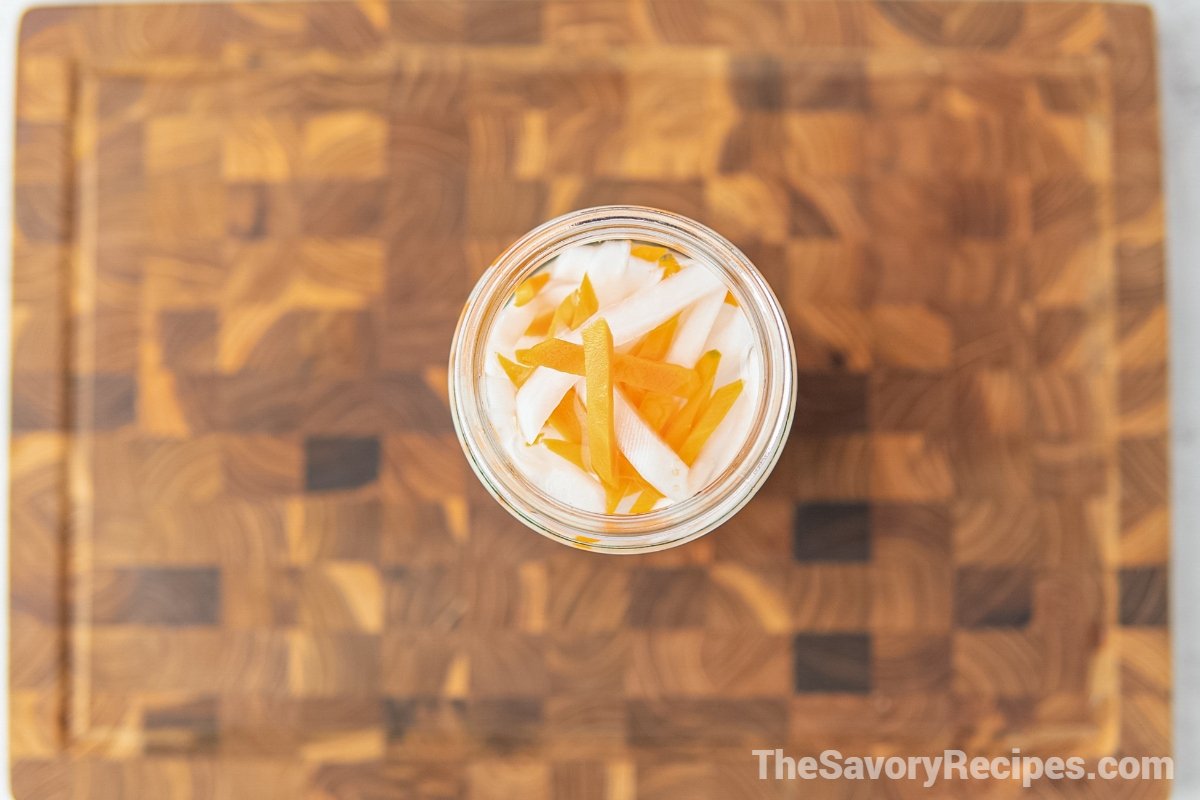
Just by simple steps, you can pickle your carrots and daikon. Typically, these pickles have an easy-to-remember 1:1:1 ratio for sugar, water, and vinegar.
You don’t have to follow this ratio strictly. In this recipe, I prefer the slightly sour with a little bit tangy, so I used the 1:1:0.5 ratio for sugar, water, and vinegar, and you can adjust based on your own preference.
Boil water. Pour water into a bowl and put it in the freezer to cool for an hour until the water is cold. While the water is cooling, julienne your daikon and carrots. Rinse your carrots until the water runs clear. This will prevent the orange color from bleeding out of the carrots and making the daikon orange.
Combine the cold water, vinegar, sugar, and salt in a jar and mix. Add the julienned daikon and carrots. Close the lid and let it sit at room temperature for 3 days. After 3 days, put it in the fridge for storage. They can be stored in the refrigerator for up to 3 months.
Ingredients, Substitutions & Adjustments
- Daikon radish – You can use any daikon or carrots for this recipe, but I use the winter radish ( White daikon) and orange carrots for the most authentic dishes.
- Water
- White vinegar is the main ingredient that helps preserve and transform the daikon and carrot into a pickled product with a sour flavor. You can substitute it with apple cider vinegar or rice wine vinegar, but the flavor will be slightly different because these vinegars have different flavors. For the most authentic taste, I would recommend using the white vinegar.
- Granulated sugar – Add sweetness and balance out the tangy flavor of the vinegar
- Salt – Brings out the flavor of the other ingredients.
What ratio of carrots to daikon should you use?
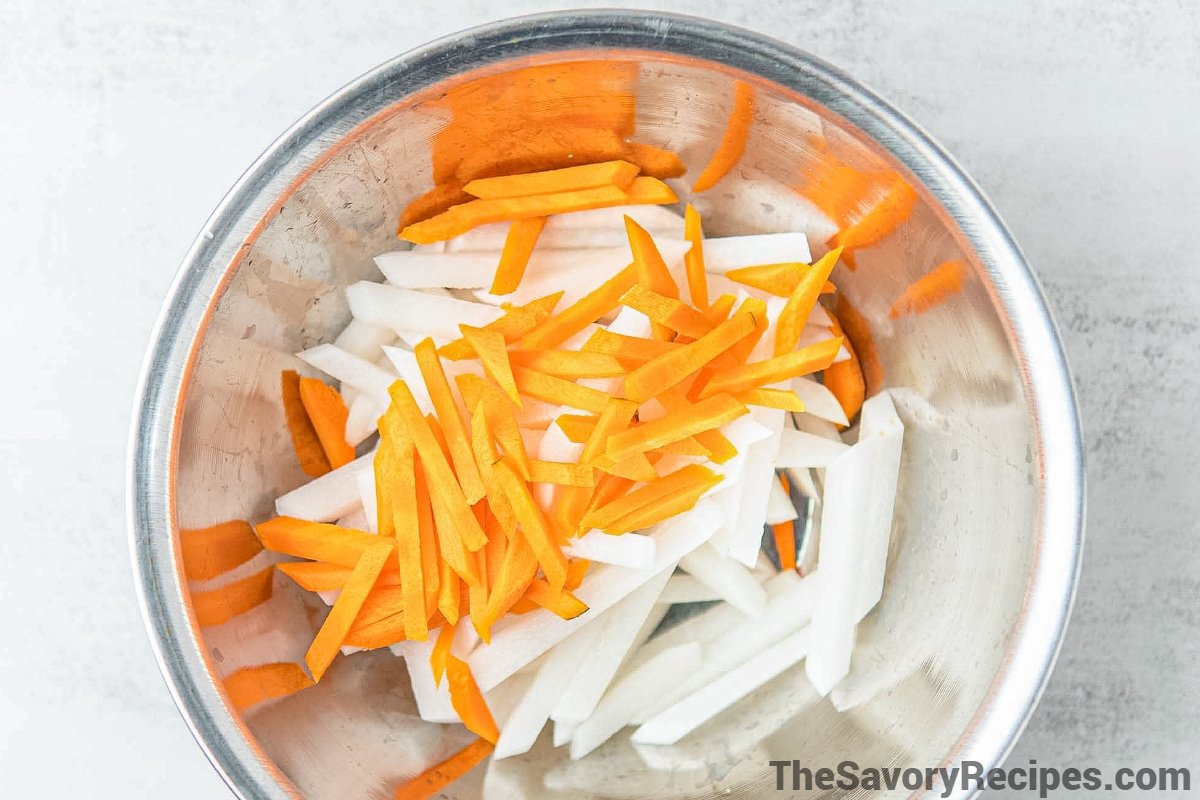
This mostly depends on your taste. If you prefer the sour flavor of the pickled daikon to the crunchy and less sour flavor of the pickled carrots, you can adjust the ratio of the daikon and carrots.
Typically, I prefer to use a 3:1 ratio of daikon to carrots. My mom told me that authentic Đồ chua mainly uses daikon, but until now, they have added carrots to Đồ chua to draw attention to the dishes.
In fact, as my parents grew up, Vietnam was a poor country, and we lacked everything. Pickling vegetables is one of our ways to store vegetables, and daikon is one of the cheap vegetables we can afford. It has changed since then. In the US, carrots seem to be more affordable than daikon, but I still prefer the daikon to carrots.
How to julienne carrots and daikon?
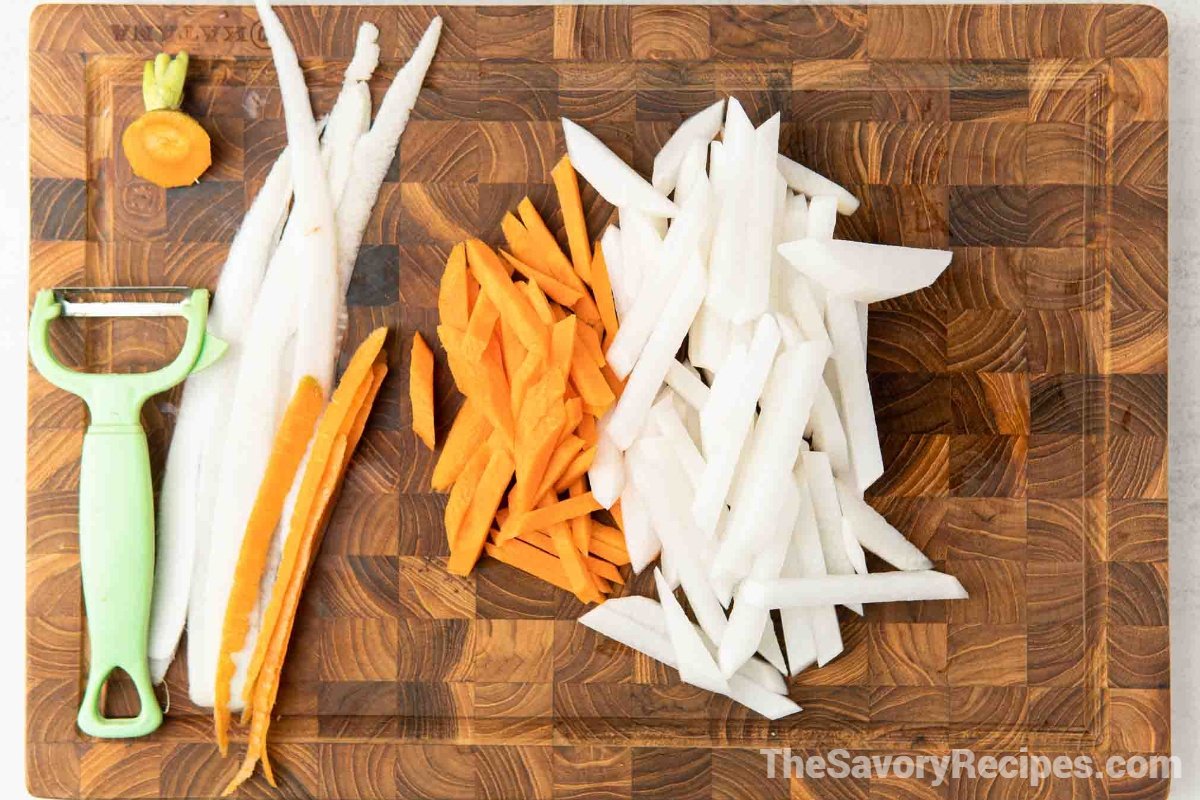
Peel and slice your daikon and carrots to the size you want. Smaller matchstick cuts will get more sour faster than larger ones, but bigger ones will give you the crunchy taste. In my opinion, I like the bigger cuts (½ inch thick and 2 inch long) because it is less sour and can be stored longer than the smaller ones.
Additionally, whatever size you cut, make sure the sliced daikon is always bigger than the carrots, because salted daikon will be less crunchy than the sliced carrots of the same size.
Another option for julienne carrots and daikon is using a mandolin slicer or a sharp box grater for uniform cuts. If you use the mandolin for the first time, make sure to use it slowly for the safety of your fingers, or just buy a separate kitchen mandoline guard or a cut-resistant glove.
As you near the nub of the carrots or daikon that you’re slicing, grab a knife and finish it that way, or compost the excess rather than putting your fingers at risk.
How to make the pickling liquid?
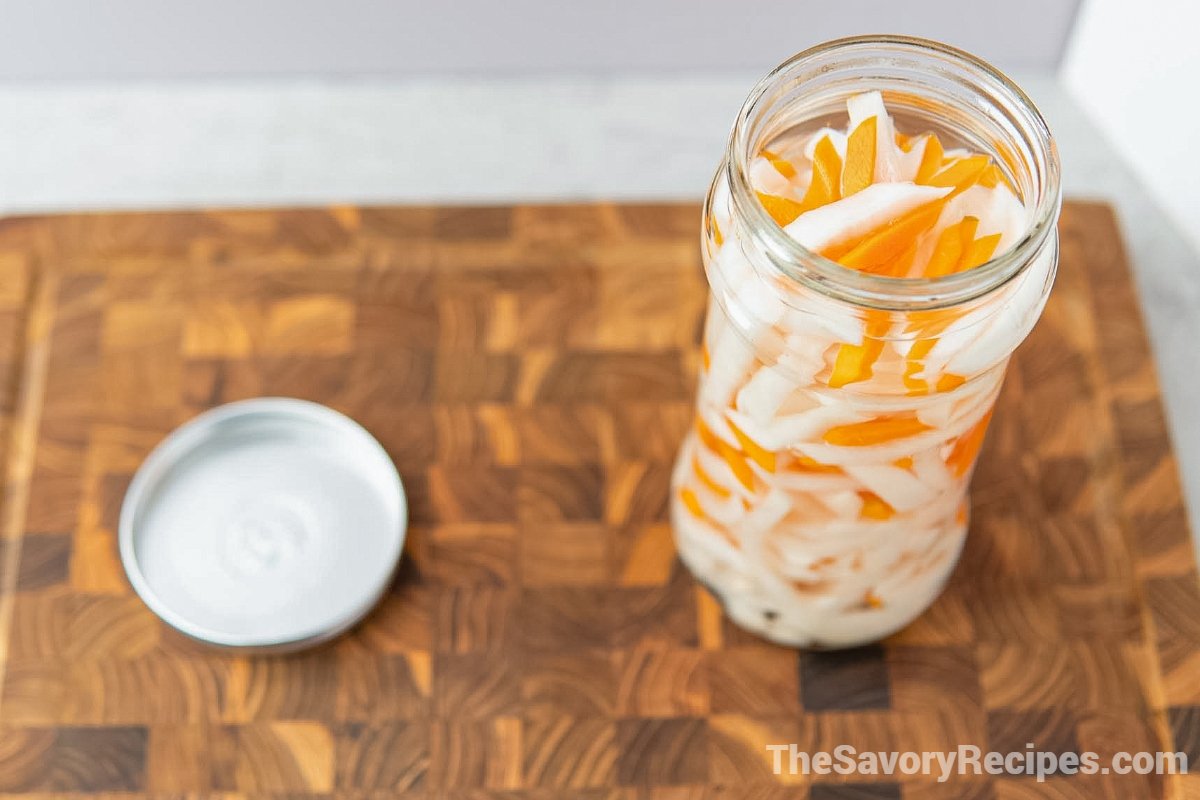
My mom customized this pickling recipe liquid to be less pungent, less sour, and less sweet compared to what you commonly taste at most Vietnamese restaurants before, because the liquid will be less vinegary will.
My mom originally customized this recipe to be slightly less pungent with vinegar and less sweet than what you may taste at most Vietnamese shops. This less vinegary formula is simply a matter of preference, and it will make your đồ chua last longer in the fridge before it expires.
The sweetness is also a preference: I find that most restaurant recipes are skewed towards being flavor-bombs, including being too sweet, so we pulled that back in this recipe here, too.
Following this recipe also creates đồ chua that’s ready to be added to nước chấm to taste–you won’t need to wring out or rinse the pickles beforehand.
If you’re in a rush and want to eat these within a few hours and don’t care to save extras for another day, adjust the solution for an even higher vinegar to water ratio.
FAQ
How long does Đồ chua last?
Đồ chua ( Vietnamese pickled daikon and carrots) can last up to 2 months in good conditions.
How do you store Đồ chua?
You can store Đồ chua in the fridge and eat it with your meals. Once it’s in the refrigerator, the pickling process is slowed, so it won’t pickle too much while you eat the rest. I eat a jar of Đồ chua within the span of about 2 weeks.
What kind of jar should I use?
Usually, I use a glass jar because it’s the best choice for your health, but you can use whatever you want.
What to eat with Đồ chua?
Đồ chua goes great with any fatty, salty dishes such as bánh mì (Vietnamese sandwiches), cơm tấm (Vietnamese broken rice), bún thịt nướng (Vietnamese grilled pork and noodles), bột chiên (Fried rice flour cake), bánh xèo (Vietnamese savory crepes ).
Are pickled vegetables good for you?
Pickled vegetables, like đồ chua, have a lot of healthy benefits due to the fermentation brine that creates good bacteria in the body, but eating too many pickled vegetables with meat or fish can create nitrosamines that can cause cancer, commonly stomach cancer.
Can you use this recipe to pickle other vegetables?
You can pickle whatever vegetables you want; they suit your taste.
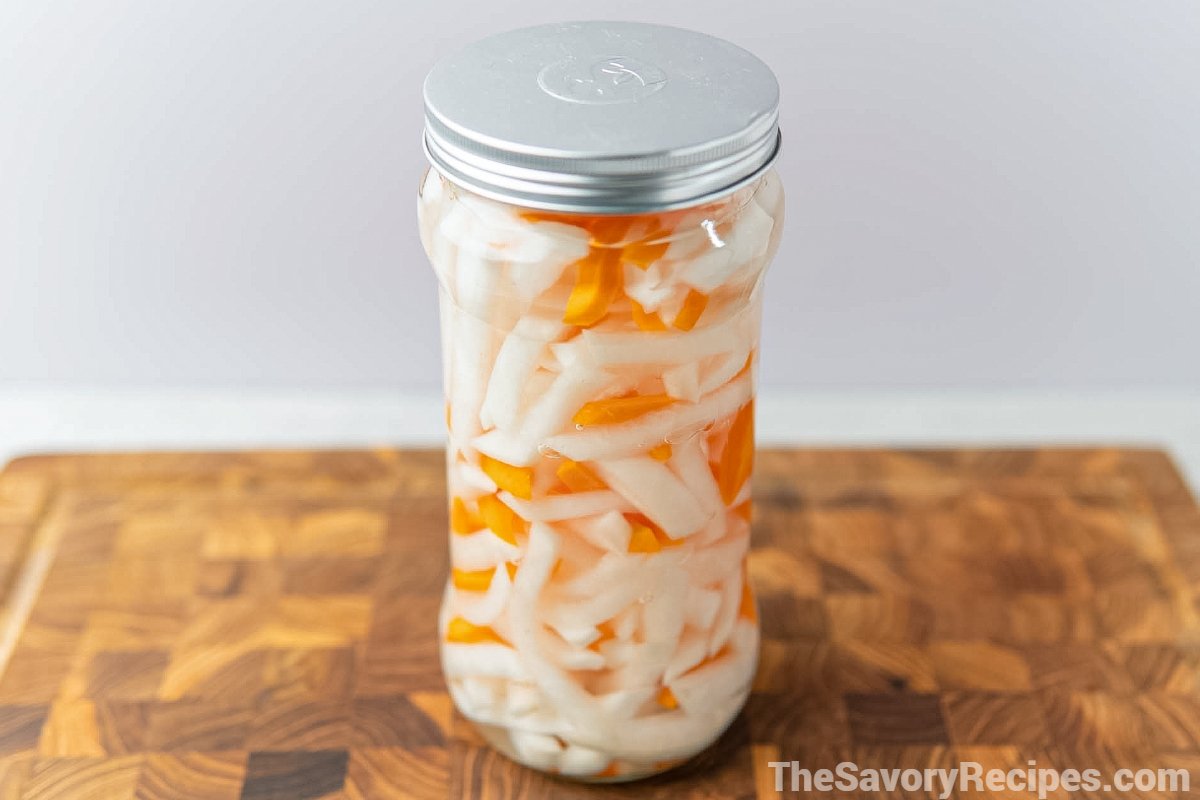
Đồ Chua – Vietnamese pickled carrots and daikon
Equipments
- 1 glass jar
- 1 Mandolin slicer
Ingredients
- 1 1/2 lb Sliced daikon (approximately 1 large daikon or 2-3 medium daikon)
- 1/2 lb Sliced carrots (approximately 1 medium carrot)
- 1 tbsp salt
- 1 tbsp granulated sugar
- 3/4 cup hot water
- 1/5 cup white vinegar
Instructions
- Add salt and granulated sugar to a pot, mix to dissolve, and boil on high heat. Once it hits a boil, add vinegar, remove from the heat, set aside, and let it cool to room temperature.
- While the water is cooling, peel the daikon and carrot, then julienne them into small matchsticks. The images above show detailed step-by-step instructions on julienne daikon and carrots.
- In a large bowl, evenly sprinkle sliced daikon and carrots with salt and toss to coat. Soak for 30 minutes.
- Rinse thoroughly to remove the salt and, in small handfuls, and squeeze as much moisture as possible.
- Add the julienned daikon and carrots into a jar, then pour the pickling water to the top. Close the lid and let it sit at room temperature for 24 hours, then put it in the fridge for storage.

